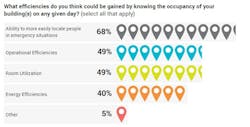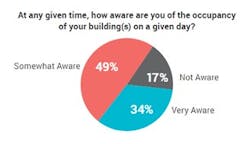How to Increase Workplace Safety and Resource Efficiency
While some of today’s enterprise organizations have a grasp on the everyday usage of their buildings and related activities, there are a vast majority of organizations that lack the ability to account for these factors. Many facility managers and directors—alongside their counterparts in IT and physical security—face growing challenges amid an expanding threat landscape. This is especially true during the global pandemic. They must balance workplace safety with concerns for finding integrated solutions with the capability to boost security, improve emergency planning, help meet public health and other regulatory or policy compliance, and optimize and refine resource allocation.
Physical security systems exist to help these leaders with safety and building asset protection. Innovative platforms, such as real-time location services (RTLS), offer a transparent view into how a workplace and its facilities are utilized and how many people are on site at any given time. While physical security systems can address some of these needs, RTLS -enabled platforms offer a deeper understanding of a facility’s occupancy and usage, which results in a safer and more efficient, compliant and resilient workplace.
Understanding Workplace Utilization
HID Global surveyed 1,598 individuals including facility, security and IT professionals to explore attitudes about real-time location services technology and the three ways it can be used to increase workplace safety and resource efficiency.
#1 Optimize and Refine Resource Allocation by Understanding Occupancy Levels and Building UsageMore than 70% of respondents reported not having a vision or plan around implementing a real-time location services platform to enable solutions. This indicates an opportunity for leaders to be educated on the advantages that come with implementing strategies for facilities. Many respondents see the benefits of knowing occupancy levels and which efficiencies can be gained as a result: 68% reported the ability to locate people more easily in emergency situations; 49% said operational efficiencies; 49% reported room utilization, and 40% said energy efficiencies.
#2 Boost Security Through Better Location Awareness
Physical security systems are implemented to give security leaders the flexibility and control to grant or restrict access to various sectors of a building. However, location services technology and the use of RTLS can help enhance both.
During an emergency, 40% of respondents reported using an access control system to account for employees, while another 38% reported using a time and attendance system, and 32% used a paper roster. More than 29% reported using video surveillance to gain this information and 26% use electronic rosters.
Physical security solutions, including access control and video surveillance, would ideally be used for their intended purposes alongside RTLS. This offers leaders additional benefits, such as tracking visitors through a facility. In addition, RTLS platform-enabled solutions allow for the creation of virtual zones and alerts or alarms that are activated when a person enters a designated area. Almost 43% of respondents said they are unable to account for visitors within a building at any given time, the lack of which can create a real security hazard.
#3 Increase Safety with Emergency Response and Crisis Management Powered by Data
Almost 50% of respondents reported using paper rosters as a means to register and track visitors to a facility; 43% use access control systems, while 35% use video surveillance. Access control and video surveillance systems can be helpful in gathering intelligence about an incident, but paper rosters lack the ability to be dynamic or integrate seamlessly with other tracking tools to serve security leaders or facility managers in case of emergency. And unless an exit policy exists with physical access control system—or security doors or turnstiles exist to control single exit and entry into buildings, floors, or areas—it’s very difficult to understand which employees or visitors are in what areas, or even if on the premises, when fast responses are required.
Response protocols are a high priority for organizations, with 87% percent reporting they have protocols in place for fire emergencies, 67% for natural disasters and 62% for a health emergency. A little more than half (53%) report having active shooter response protocols in place, and 43% say they have a plan in place to deal with biohazards. While 38% of respondents reported that they know how many employees are on the premises and where they are during an emergency, a staggering 33% do not know either of these things. Another 21% claim they know how many people should be present during an emergency, but not where they are in a building.
Helping facility managers and first responders with real-time location of building occupants is one-way occupancy data from RTLS platforms can be used to improve safety and be integrated into preparedness planning. RTLS technology, in particular, can provide first responders with “last known location” features and muster counts with reporting, making it easier to locate people when they have exited a building or are still inside a building during an evacuation. Because RTLS isn’t reliant on entry and exit policies or security doors for counts, the solutions it enables provide accurate data and reporting in any specified time frame when seconds count. Not only does this add another tool to the available life safety features in a facility, but it also allows emergency response to be more streamlined.
Fueling Automated Social Distancing and Contact Tracing
RTLS capabilities are proving ideal for organizations seeking that help safely enable employees to return to workplaces as a result of COVID-19 business shutdowns. They help in three crucial ways:
Deliver dynamic workplace safety: RTLS technology like the HID Location Services for Workplace Safety physical distancing application leverages Bluetooth Low Energy (BLE) fobs that alert employees when they are closer than 6 feet (2 meters) for a specified period of time. It uses the same fob for rapid contact tracing.
Streamline Rapid Response: RTLS solutions provide a full digital trail of an employee’s whereabouts and historical interactions while at work, making it possible to immediately respond to cases and activate isolation procedures as needed.
Automate Compliance: RTLS solutions automate a variety of compliance processes from visitor management to physical distancing, contact tracing, and hygiene behavior. This removes the manual and potentially laborious efforts around adhering to new health and safety procedures.
RTLS solutions are easy to deploy for social distancing and contact tracing:
1. Employers first define distancing policies and alert parameters.
2. Zones can be created with geofences around high-traffic areas (breakrooms, hallways, lobbies) to minimize large congregations of people.
3. Next, BLE fobs are issued to employees, visitors and contractors to carry while at work. Using peer-to-peer capabilities, the fob will flash and sound a brief audible alert when employees are within 6 feet (2 meters) for more than 2 minutes (or as configured by administrator).
4. Detailed reporting is immediately available so contact tracing can be conducted while also triggering safety protocols, as needed, using historical data on movement and interactions.
Today’s RTLS solutions enable organizations to better manage building resources and the flow of people throughout a facility, optimize room utilization, and streamline efficiencies.
These benefits boost security, improve emergency response, mitigate risk and meet regulatory compliance, the value of which is magnified now as organizations meet the challenges of managing workplace safety through the global public health crisis. Coupled with physical security solutions such as access control and video surveillance, RTLS technology adds an additional layer of protection for organizations striving to provide a safe, effective and resilient workplace.
About the author: Matt Barnette is Vice President of Physical Access Control Solutions for North America with HID Global.
About the Author

Matt Barnette
Matt Barnette
Matt Barnette is President & CEO of PSA Network, the world’s largest systems integrator consortium made up of North American security and audio-visual systems integrators.
Barnette joined the PSA Network as CEO in January of 2021. He is a seasoned veteran in the physical security industry with over 30 years of experience in management and executive roles that include Mercury Security, HID Global, and AMAG Technology. He is a member of ASIS International, BICSI and SIA.


